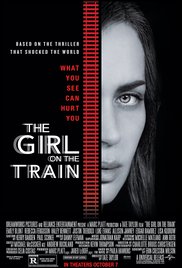(Spoiler Alerts)
There are hundreds of books that have been made into movies. A few I’ve watched the movie and then read the book including Gone with the Wind and Jurassic Park. However, most of the time, I’ve read the book first and then saw the movie.
Recently, I read the psychological thriller by British author Paula Hawkins, The Girl on the Train. The novel debuted at No. 1 on The New York Times Fiction Best Sellers in 2015. I put off reading the book until one day I found it in a used bookstore and snatched it off the table. The cashier told me, “Wow, you’re lucky to find this one. It’s so popular.”
The Girl on the Train was on the best-seller list for more than 80 weeks. The movie, based on the book, was released in October and can now be found on TDS on Demand.
Unfortunately, the movie received mixed reviews and I agree with them. I was disappointed in the movie for three reasons: it did not flow well, the filming location and character development.
Lack of flow
In the novel, the back and forth perspective from the characters is very obvious because the chapters are named after the character that is “speaking.” However, you really don’t get that feel in the movie, which is a little choppy, especially for those who have never read the book. This movie was created on the super-fast track, a mere 21 months after the book was published, and the choppiness comes across when you watch it.
Filming location
I also disagree with the decision to film in New York City instead of London. The train scenes were too far away from the homes. Because of the distance from the train tracks and the homes, I had a hard time believing the lead character Rachel Watson’s connection to the families who lived in the homes. Could she really see into their homes when the trains were so far away?
If they needed to film in the United States, a much preferred filming location would have been Chicago, where the train tracks are really very close to the homes in the city and suburbs.
Also, the homes in this film were too suburban – big homes and big yards. In the novel, the homes were more like row houses in a city. It’s hard to believe in the movie that Scott and Megan Hipwell can afford such a nice home in New York at such a young age.
Character development
In the novel, characters were “flushed out” and brought more to life. This includes her roommate Cathy, who received too small of a role in the movie. Cathy was also not portrayed as Rachel’s sole friend in the movie as she was in the novel.
In addition, Tom Watson seemed pretty creepy throughout the novel because hints were dropped here and there about his personality. However, in the movie, Tom seemed odd but nothing stood out until the end when the twists and turns go into full Tom “Creepy” Watson mode.
Other differences between the movie and the novel include:
- One main detective in the movie, compared to two detectives in the novel
- The bar/bathroom scene with Rachel and a friend drinking it up, which never happened in the novel
- The real reason Tom was fired told to Rachel by the wife (Lisa Kudrow) of his boss, which also never happened in the novel
- There was a blue dress in the novel but not in the movie
- At the end of the movie when Rachel visits the cemetery, there was one grave (instead of two in the novel)
Even though the movie did live up to the character development in the novel, there were still plenty of drama to keep my husband, who did not read the book, and me interested. My husband gave the movie a fairly-healthy thumbs up.


No comments yet.